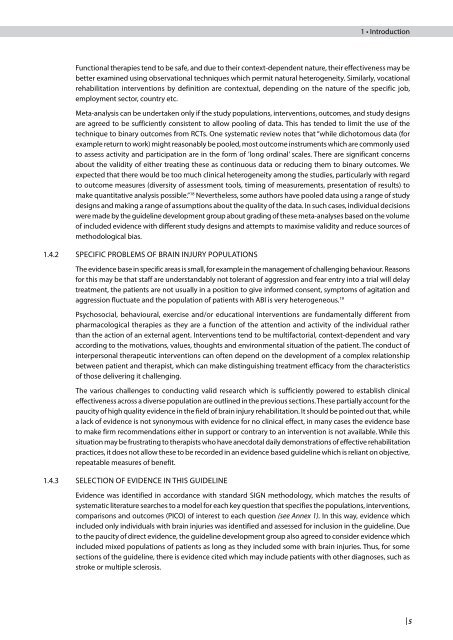sign130
sign130
sign130
Create successful ePaper yourself
Turn your PDF publications into a flip-book with our unique Google optimized e-Paper software.
Functional therapies tend to be safe, and due to their context-dependent nature, their effectiveness may be<br />
better examined using observational techniques which permit natural heterogeneity. Similarly, vocational<br />
rehabilitation interventions by definition are contextual, depending on the nature of the specific job,<br />
employment sector, country etc.<br />
Meta-analysis can be undertaken only if the study populations, interventions, outcomes, and study designs<br />
are agreed to be sufficiently consistent to allow pooling of data. This has tended to limit the use of the<br />
technique to binary outcomes from RCTs. One systematic review notes that “while dichotomous data (for<br />
example return to work) might reasonably be pooled, most outcome instruments which are commonly used<br />
to assess activity and participation are in the form of ’long ordinal’ scales. There are significant concerns<br />
about the validity of either treating these as continuous data or reducing them to binary outcomes. We<br />
expected that there would be too much clinical heterogeneity among the studies, particularly with regard<br />
to outcome measures (diversity of assessment tools, timing of measurements, presentation of results) to<br />
make quantitative analysis possible.” 18 Nevertheless, some authors have pooled data using a range of study<br />
designs and making a range of assumptions about the quality of the data. In such cases, individual decisions<br />
were made by the guideline development group about grading of these meta-analyses based on the volume<br />
of included evidence with different study designs and attempts to maximise validity and reduce sources of<br />
methodological bias.<br />
1.4.2 SPECIFIC PROBLEMS OF BRAIN INjURy POPULATIONS<br />
The evidence base in specific areas is small, for example in the management of challenging behaviour. Reasons<br />
for this may be that staff are understandably not tolerant of aggression and fear entry into a trial will delay<br />
treatment, the patients are not usually in a position to give informed consent, symptoms of agitation and<br />
aggression fluctuate and the population of patients with ABI is very heterogeneous. 19<br />
Psychosocial, behavioural, exercise and/or educational interventions are fundamentally different from<br />
pharmacological therapies as they are a function of the attention and activity of the individual rather<br />
than the action of an external agent. Interventions tend to be multifactorial, context-dependent and vary<br />
according to the motivations, values, thoughts and environmental situation of the patient. The conduct of<br />
interpersonal therapeutic interventions can often depend on the development of a complex relationship<br />
between patient and therapist, which can make distinguishing treatment efficacy from the characteristics<br />
of those delivering it challenging.<br />
The various challenges to conducting valid research which is sufficiently powered to establish clinical<br />
effectiveness across a diverse population are outlined in the previous sections. These partially account for the<br />
paucity of high quality evidence in the field of brain injury rehabilitation. It should be pointed out that, while<br />
a lack of evidence is not synonymous with evidence for no clinical effect, in many cases the evidence base<br />
to make firm recommendations either in support or contrary to an intervention is not available. While this<br />
situation may be frustrating to therapists who have anecdotal daily demonstrations of effective rehabilitation<br />
practices, it does not allow these to be recorded in an evidence based guideline which is reliant on objective,<br />
repeatable measures of benefit.<br />
1.4.3 SELECTION OF EVIDENCE IN THIS GUIDELINE<br />
1 • Introduction<br />
Evidence was identified in accordance with standard SIGN methodology, which matches the results of<br />
systematic literature searches to a model for each key question that specifies the populations, interventions,<br />
comparisons and outcomes (PICO) of interest to each question (see Annex 1). In this way, evidence which<br />
included only individuals with brain injuries was identified and assessed for inclusion in the guideline. Due<br />
to the paucity of direct evidence, the guideline development group also agreed to consider evidence which<br />
included mixed populations of patients as long as they included some with brain injuries. Thus, for some<br />
sections of the guideline, there is evidence cited which may include patients with other diagnoses, such as<br />
stroke or multiple sclerosis.<br />
| 5


